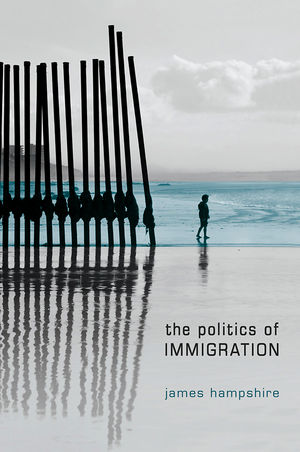Immigration is one of the most contested issues on the political agenda of liberal states across Europe and North America. While these states can be open and inclusive to newcomers, they are also often restrictive and exclusionary. James Hampshire sets out to examine the sources of these apparently contradictory stances, locating answers in the nature of the liberal state itself. Inez von Weitershausen finds his approach of focusing on shared features of liberal states across various regions innovative and enlightening.
 The Politics of Immigration: Contradictions of the Liberal State. James Hampshire. Polity Press. September 2013.
The Politics of Immigration: Contradictions of the Liberal State. James Hampshire. Polity Press. September 2013.
Against the latest appalling news of immigrants dying just hundreds of metres off the Italian coast in an attempt to reach Europe, and in light of recent data published by the United Nations revealing that more than 230 million people worldwide are international migrants, the insights of James Hampshire’s The Politics of Immigration seem ever more relevant.
In this thorough analysis of the immigration practise of “rich liberal democracies” in North America, Oceania, and Europe, the expert at the Sussex Centre for Migration Research explains how representative democracy, constitutionalism, capitalism, and nationhood form “liberal paradoxes” that push states to simultaneously pursue “politics of openness” and “politics of closeness”.
In contrast to other relevant authors in the field, Hampshire chooses not to focus on one particular region, but instead identifies a number of common features shared by a rather large number of states. Without claiming to provide a comprehensive definition of the liberal state as such, he convincingly argues why the latter is often seen to have a “Janus face” with regard to immigration policy. In eight thoroughly researched chapters, Hampshire elaborates on how representative politics and nationhood are driving forces behind a restrictive policy approach, whereas capitalism and constitutionalism are sources that urge states to open their boarders for foreigners. He thus comes to the conclusions that the “intractable nature of immigration policy is not a failure of governance, but rather a reflection of contradictory imperatives of the state” (p.2).
Among the observed countries, Hampshire identifies Canada closest to a state and in which “public opinion is moderate, constitutional protections are strong, narratives of national identity include immigration, and businesses demand labour migrants” (p.53). European countries, by contrast, he sees to be located closer towards the restrictive end of the openness-closeness spectrum. At the same time, the author establishes that all liberal states tend to simultaneously pursue diverging policies towards different migrant groups, leading to a set of “complex assemblages of immigration policies” (p.55).
Drawing on the latest research and insights from fields as diverse as economics, law, party politics and international relations, Hampshire raises a number of different questions throughout the book. At first he seeks to inquire why immigration-sceptical public opinion is often not translated into an equally restrictive government policy. His convincing answer suggests that both practical and normative reasons account for this outcome. On the one hand, businesses successfully communicate their need for immigrants as a work force; while on the other hand, politicians are constrained by the legally-protected principles of family migration and asylum.
A second question then asks why governments find it so difficult to adapt to the age of migration. Here, Hampshire identifies causes at the national and the international level. He finds that even though liberal states are characterized by major differences due to different historic attitudes towards and experiences with immigration and the varying influence of particular actors and institutions, they do share notions of sovereignty and national interests that make cooperation on migration issues rather difficult. He picks up on findings made elsewhere according to which “cooperation on migration is ‘not natural’ for states” (p. 85) and discusses how through incentives and issue-linkages such as visa concessions, trade agreements, and development aid concerted action can be achieved nonetheless. Importantly, Hampshire does not shy away here from discussing also inconvenient truths, such as that negotiations on migration issues usually do not take place on a level playing field between Northern and Southern states.

Particularly insightful is also Chapter 7 which focuses on the relevant issue of integration and thus moves beyond the question of how and why states grant access to their territory and state structures or why international cooperation is such a challenge. Hampshire debates issues as sensitive and topical as the attitude towards Muslims post 9/11 and fears regarding a loss of national identity in an era of increased mobility. His judgement is that “civic integration policies have become the liberal state’s chief weapons in a struggle to maintain this identity” and that “the vehemence with which this battle is often fought reveals the persistent importance of nationhood” (p.155).
Overall, Hampshire’s book is recommendable for a wide range of audiences. Those, familiar with the immigration topic and discourse will find his approach of focusing on shared features of liberal states across various regions innovative and enlightening and appreciate the elaborated way in which he tackles the issue. “Newcomers” to migration research, by contrast, are likely to appreciate the clarity with which essential definitions are offered and relevant debates introduced. As such, the reader will learn about basic categories (e.g. the distinction between refugee -, labour migration -, and international travel-regimes) and get an insight into the academic debate on whether migration constitutes a public good (p.84) or on the prospects for a comprehensive global migration regime and effective international institutions. Readers from other disciplines might further appreciate the introduction to essential concepts of International Relations such as multi-level governance, cooperation and Europeanization, illustrated by well-chosen examples.
In order for the book to be more accessible to non-experts in the migration field, however, a slightly less complex language might have been advisable and the book would have profited from a more detailed analysis of the wide range of examples, some of which remain rather superficial. His account of how right-wing political parties have been particularly powerful in mobilizing anti-immigrant sentiments, for instance, would have been even more convincing and educative had he not mentioned important cases such as Denmark and Switzerland simply “en passant”. After all, their respective decisions to initiate legislation to reintroduce border controls and prohibit the construction to minarets have been and continue to be highly relevant debated issues.
Furthermore, an appendix with tables providing an overview of the major differences and commonalities between the immigration policies discussed and data on the number and status of immigrants and international agreements would have been useful additions to the book. This applies in particular to those countries whose immigration policies tend to be less well known in Europe, e.g. those of Oceania. These limitations, however, do not challenge the overall high quality of this interesting piece of research whose relevance is likely to continue in the future due to the finding that “for rich liberal states, immigration is here to stay” (p. 156).
——————————————————————-
Inez von Weitershausen is a PhD student and member of staff at the LSE’s International Relations Department. Her doctoral research concentrates on European foreign policy with a special focus on crisis response and the Southern Neighborhood. She holds degrees from Bucerius Law School Hamburg and University of Bonn, Germany. Read more reviews by Inez.







1 Comments